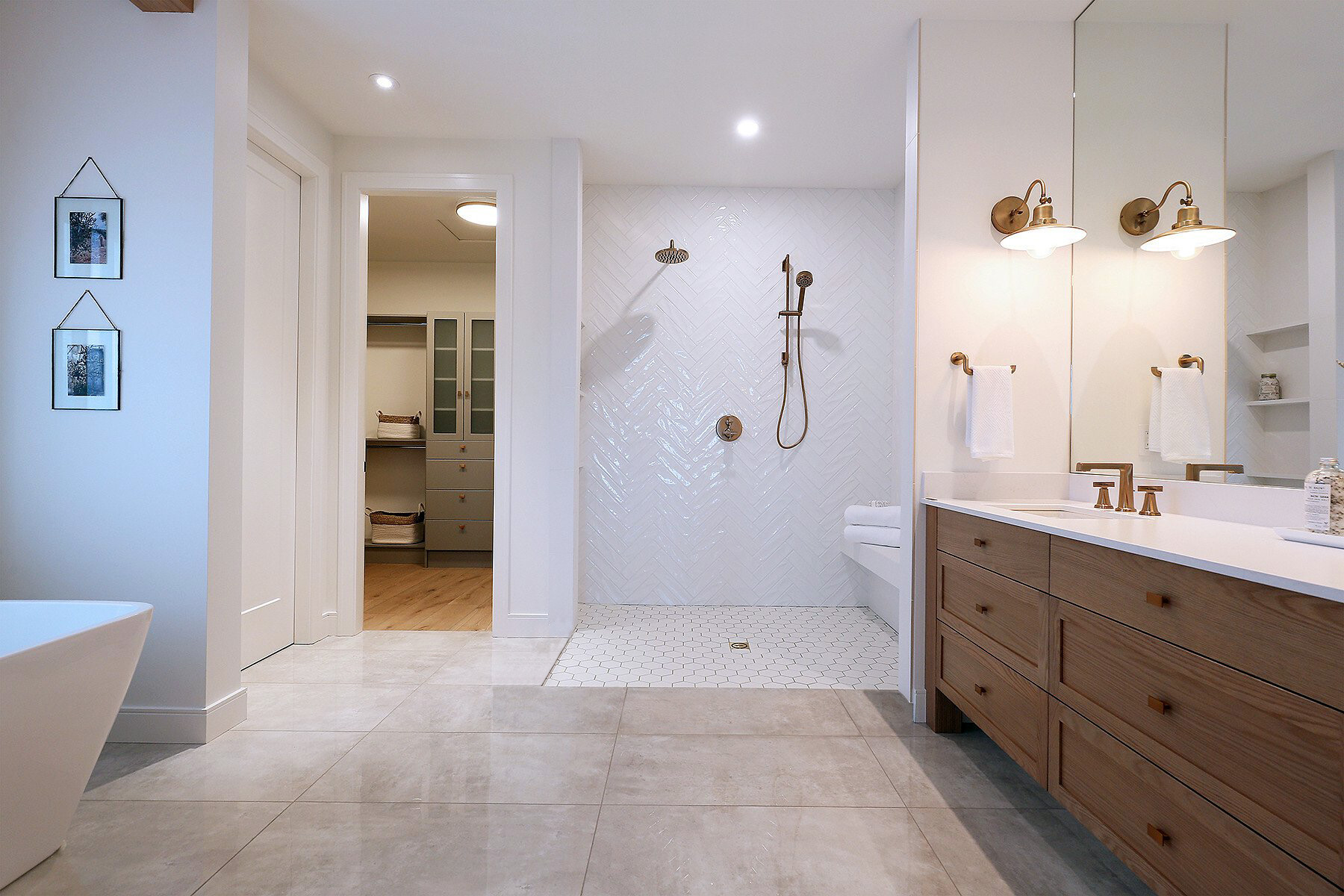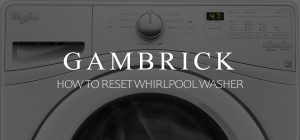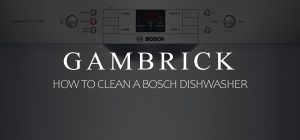What Is A Roll In Shower?
Roll in showers are designed to be wide open without a curb, which allows a wheelchair to roll comfortably in and out. Most walk in showers have a 4 to 6 inch high curb at the bottom which divides the shower from the rest of the bathroom. It’s designed to keep water inside the shower but prevents a wheelchair from rolling in. Roll in showers don’t have the curb so they’re much easier to access. However, without a curb, water can escape and flood the bathroom. To prevent this, we install drains in both the shower and bathroom area. Roll in showers are designed large enough for a wheelchair to maneuver within the stall and typically include a seat and safety equipment.
Roll in showers can be made from fiberglass with polyester gel-coat, acrylic or tile that covers the walls and floor.
- Acrylic sheets are heated and vacuum formed to a mold. The material gets thinner where the acrylic is stretched and may lose shape due to heat. This is the cheapest option.
- Polyester gel-coats are sprayed into a mold and cured creating a uniform and consistent thickness throughout the shower. This is a mid priced option.
- Tile showers can be custom built to any specification. Tile is the most expensive way to build a roll in shower.
Roll in showers are generally built with plywood backing instead of dry-wall which makes them very strong. This makes it easier to install safety equipment as needed instead of just where the studs are. I highly recommend building your shower like this.
The most important element of a roll in shower is the lack of a curb at the entrance of the shower. This means the bathroom and shower floor are level so you can easily roll a wheelchair in and out.
Understanding A Roll-In Shower
The purpose of the roll-in shower is being able to roll a wheelchair in and out of it.
Roll in showers look a lot like standard walk in showers except for the floor design. Walk in showers have a curb that separates the shower and bathroom floor. This keeps water inside the shower but prevents a wheelchair from rolling in. A roll-in shower doesn’t have a curb, so the shower and bathroom floors are level. This makes rolling in a wheelchair very easy to do.
Because a roll-in shower doesn’t have a curb, water may leak out of the shower and onto the bathroom floor. To deal with this we sometimes install a 2nd floor drain in the bathroom area. I recommend a trench drain. Install it along the entire shower entrance to catch water as it runs onto the bathroom floor.
Roll-in showers are shaped just like regular showers. The most popular design features 3 closed walls and one open which generally has a glass door or shower curtain. But you can build them in other configurations just like you can with a standard shower.
Roll in showers can also include a shower curtain or glass door which helps keep water inside the shower area.
Most roll in showers also include seating so you don’t have to get your wheelchair wet if you don’t want to.
Since most roll in showers are for people in wheelchairs, follow ADA guidelines and install safety equipment like grab bars.
When designing a roll-in shower, keep in mind that the person using it will probably be in a wheelchair which is lower than a typical standing person. Adjust the height of diverters, soap dishes, shelves and shower heads accordingly.
Roll-in master bath shower featuring a built in bench seat and frameless glass doors.
Features Of Roll In Bathroom Showers
All roll in showers are designed with a floor you can roll a wheelchair into. That’s where the name roll-in comes from. But they also contain a bunch of other features.
Bench seating , soap dishes, grab bars, shelving, wide designs and hand held shower wands are all some of their other features.
Bench seating provides a comfortable place to sit if you don’t want to bathe in the wheelchair. And they can be often be folded up and down so they don’t take up much room when not in use. Soap dishes and shelves can be built at a lower height than in a standard shower for easy access while seated.
Roll in bathroom showers can be made fully ADA compliant for the disabled.
- Grab Bars: Most roll-in bathroom showers include grab bars. They can be installed horizontally, vertically or on an angle.
- Shower heads: Shower heads can be mounted on vertical bars that are height adjustable. They’re great for people in wheelchairs or standing up. And they can also be handheld with a long enough hose for easy use.
- Curb: We generally remove the curb in our roll-in showers. However, if you want one, they should be about 0.25″ – 0.5″ high. 0.5″ curbs have a beveled edge that’s are easy to roll over, 0.25″ curbs do not.
- Shower seats: Shower seats or benches can be permanently built in or bolted to the wall. Bolted seats can fold up or down when not in use.
- Double Drain: Since our roll-in showers don’t feature a curb, we sometimes install a 2nd drain in the bathroom. Trench drains running along the entrance of the shower work great.
- Open Design: Roll-in showers should be wide and open enough to comfortably maneuver a wheelchair in without banging the walls.
Benefits Of Roll-In Showers
A roll-in shower allows people in a wheelchair to live an independent lifestyle and shower all by themselves. But it’s not just for the disabled. Anyone can use a roll-in shower.
If you have trouble getting over the side of a tub or don’t like the curb because it’s a tripping hazard, build a roll-in bathroom shower. By eliminating the curb you can walk right into the shower without stubbing a toe or tripping. They’re more comfortable because the floor of the shower and bathroom are the same.
Because the bathroom and shower floors are level, you can have a seamless design. This gives you a bit more design flexibility. Most walk in showers use different tile for the bathroom and shower floors because there’s a dividing curb to separate the two floors. But roll-in showers eliminate the curb so you can run the bathroom tile into the shower.
The shower head bar is a nice feature too. It’s great for people of different heights and children. And it also comes in handy when showering large dogs.
Personally, I love a shower with a seat. This is one of my favorite features in a roll-in bathroom shower. Not all walk-ins include them.
I also really like the double drain. Even though walk-in showers include a curb to stop water, it sometimes gets out anyway. Having an additional drain in the bathroom floor makes cleaning much easier. It’s also very helpful when I mop the floors.
Roll-In Shower Maintenance
Roll-in bathroom showers are no harder to clean and maintain than a traditional walk in or tub shower. But you should adjust your cleanser based on the type of material your shower is made of.
Do not use abrasive cleaners on acrylic or gel-coat shower because they may scratch or dull the surface. Clean these showers using regular liquid cleaners. I recommend testing a cleanser on an inconspicuous location first if you’re unsure. And make sure the cleanser you use specifically states it’s for the type of shower material you have. When in doubt, basic soap and water always works.
For tile roll-in showers, pretty much any cleanser works. You can use harsher cleaners with tile and grout.But be careful if you’ve got stone tile in the shower. They’re softer than porcelain. If you’re unsure, I’d test a cleanser on a small location first.
Use metal cleaners for the shower bar, grab bars, shower head, etc. Anything metal can be cleaned with an approved metal cleanser. I typically stay away from abrasive cleaners here too because you can scratch the metal finish.
Some roll-in showers have windows. Use glass cleaner on the glass and something mild on the window frame.
If your shower has a sealant like caulk or silicone, which most do, use something mild on them. An abrasive cleanser can remove the caulk which can cause leaks.
I like to use a mold and mildew killing spray in my showers too. After the shower is clean, spray and wipe things down with the cleaner to prevent mold growth. Corners are areas that stay damp when the showers not in use are the most common areas mold grows.
Don’t forget to clean the ceiling. Steam builds up on the ceiling and can lead to mold growth.
How Much Does A Roll-In Shower Cost?
Pre-fabricated roll-in shower units that can be installed into an existing bathtub or shower area are typically sold as kits that include walls and a shower pan. Prices start around $1,200 but can cost over $5,000. It depends on the size and extras you buy with the kit. Grab bars, seat, shower bar, shower head, etc. are all extras. (installation and other materials are extra).
Basic roll-in shower kits that include grab bars and a shower bench start around $3,000 (installation and other materials are extra).
Roll-in shower kits come in one, three or five pieces. There are no seams in one-piece roll-in shower kits but they must be able to fit inside the home for installation. One-piece kits are great because the lack of seams means they can’t leak, But they’re hard to squeeze through a doorway. It’s easiest to install these in a new construction home or during a bathroom renovation.
Three or five piece showers are easier to move into a bathroom but they have seams. The pieces fit together to make the shower water tight but they can sometimes leak. I recommend using silicone at the seams to keep them water tight.
Custom built tile roll-in showers have a wide range of prices. Tile needs a strong backing like cement board. I typically use plywood first, then a thin cement board like Hardy. The Hardy is great for tile but the plywood supports grab bars and seating. Then there’s the cost of tile, grout and labor to consider. Not to mention all the grab bars, shower head, wands, etc. and the double drain. Expect to pay over $5,000.
Finally you’ve got to include the door. Shower curtains are cheap, but a good quality frameless glass door will cost over $1,000.
What’s The Difference Between A Walk In Shower And A Roll In Shower?
The main difference between a roll-in shower and a traditional walk-in or tub shower is that roll-in showers are designed to allow wheel chair access. Roll-in showers have a very small curb, or none at all, between the shower and bathroom floor. This means you can roll a wheelchair in without any impediment.
Curbless roll-in showers have a floor that’s perfectly level with the bathroom. This creates a totally seamless design that’s super easy to use. But because there’s no curb, water can easily escape the shower floor and get into the main bathroom area. To prevent this, roll-in showers commonly feature a double drain. The second drain is located inside the bathroom or at the shower entrance to catch water escaping the shower. trench drains are great for this purpose.
Many roll-in showers are designed for disabled users so they include things like grab bars, seating, lower shelves and soap dishes and shower head bars that allow flexible usage.
Roll-in showers are often built bigger to allow a wheelchair to spin without hitting the walls. But this is optional.
Other than these small difference, a roll-in shower works the same way as a traditional shower. The diverter turns water on and off and controls temperature. Water comes out of the main shower head or multiple heads just like any standard shower.
Does A Roll In Shower Need A Seat?
A roll-in shower doesn’t need a seat. What makes it a roll-in shower is the lack of a curb. But ADA Section 608.4 requires permanent shower seats in transfer showers. These must be either folding or non-folding. So although you don’t need a seat to be a roll-in shower, if you want to be ADA compliant you probably do.
Whether or not the roll-in shower needs a seat or not, I recommend building one permanently in or bolting one on. They’re great and really come in handy even if you’re not in a wheelchair.
If you’re planning on building a roll-in shower and want to be ADA compliant I recommend contacting a builder or architect who’s familiar with ADA codes and construction practices. There are also ADA designers who can help layout the bathroom and safety equipment for you.
Standard Roll-In Shower Design
The standard roll-in shower design features a 3 walled rectangular shape. Two shorter side walls, one long back wall, and one long open entrance. The entrance has no curb, or a very small one that complies with ADA standards.
The design is at least 60” long and 30” deep with bars on all walls that don’t have seats attached. From here you can scale the bathroom up as needed. I prefer to make roll-in showers larger and more of a square shape so the wheelchair can spin comfortably without hitting walls or grab bars. Even though the minimum is 30 inches, I like to make them at least 36 to 48 inches.
The floor space outside the shower should be wide and open enough to make maneuvering and turning into and out of the shower easy.
Most roll-in showers we build also include a shower head bar with a wand to make washing easy if your standing or sitting. The wand stretches out with a long hose so you can use it anywhere inside the shower. Multiple shower heads or a rain feature can also be included which are controlled by a diverter.
Just about every roll-in shower we build also includes a built in or bolt on seat.
Accessible Showers & Bathrooms
Many people refer to roll-in showers as accessible showers or wheelchair showers. The biggest difference between a walk-in shower and a roll-in shower is the lack of a curb. You can roll a wheelchair into a roll-in shower with easy because there’s no threshold to stop you.
Many people who want a roll-in shower often benefit from a roll under vanity. Wheelchair accessible sinks give you easy access to your vanity top and faucet while providing room to maneuver.
Grab bars can also be installed around the room as needed to make the bathroom ADA compliant.
Roll-In Shower Grab Bars
Grab bars can be installed on shower walls to serve as support. They can be installed vertically, horizontally, or at an angle to help users support themselves while in the shower. Grab bars are mandatory if you want your roll-in shower to be ADA compliant.
Grab bars should be installed on all sides of the roll-in shower and mounted 33” to 36” above the floor outside the shower.
A sidewall does not need a grab bar if it has a shower chair or seat. The grab bar must span the length of the back and sidewalls, but do not overlap the seat. They should be 1.25” to 1.5” in diameter and accommodate up to 250lb.
Roll-In Shower Diverter
The diverter is what controls the water flow of the shower. They turn the water off and on, set temperature and control multiple shower heads. Setting the diverter is an important part of building a roll-in shower because they should be accessible to people in a wheelchair.
The diverter should be placed 38” to 48” above the floor. They can be placed on any wall in the shower but not directly over a seat. If the shower contains a seat, the diverter should be placed on the back wall, and should not be farther than 27” horizontally from the seat wall and 38” to 48” from the floor. This is to make using the diverter possible when sitting in the seat.
Shower Heads
Roll-in showers generally feature a hand held shower head with a long hose that makes washing easy no matter where you are in the shower.
They should be placed no more than 27” from the seat to be reachable when sitting. When installed on vertical bars, they’re typically height adjustable which makes them great for washing sitting down or standing.
Multiple shower heads can be installed inside a roll-in shower. Rain heads are a feature I really like.
Can A Roll In Shower Have A Door?
Yes, a roll-in shower can include a frameless glass door just like a walk-in or tub shower. Frames can’t be used though because it would get in the way of the wheelchair.
Keep in mind that roll-in shower are designed to be easily accessible. This means the door should not get in the way of the chair. Sliding glass doors are great for this.
If you want you’re bathroom to be ADA compliant and include a glass door, I’d recommend consulting with an architect or ADA designer. They can help you with all the layout requirements.
How Do You Keep Water In A Roll In Shower?
There’s no curb in a roll-in shower so water can easily escape. Here are a few ways you can keep it inside the shower.
- Make sure the floor pitches into the drain. This diverts any water hitting the floor into the drain and not into the bathroom.
- Use a long curtain that hits the floor, this will push water off the curtain and onto the pitched floor which goes into the drain.
- Install a rubber seal at the bottom of your glass door. This will divert water onto the floor and into the drain.
Install a second drain. In many locations this is required for a roll in shower. Any water that leaves the shower will go into the drain. Trench drains located at the entrance of the shower are great for this.
Easy To Use
Roll-in showers are easier to use than walk-in or tub showers because there’s no curb to trip over. And because the shower and bathroom floors are perfectly level, wheeling in and out is super easy too.
Seating and easy access controls are easier to use too. When you sit down, everything you need is within arms reach.
Roll In Shower Gallery
Below is a gallery filled with some of my favorite roll-in shower designs. As you can see, a roll-in shower can be just as beautiful, and in some cases even better,than a traditional walk in or tub shower design. Notice how the floor seamlessly transitions from the bathroom to the shower. This is a defining feature of the roll-in shower.
Custom bathroom with a roll-in shower, frameless glass doors and rain shower head.
Roll-in shower in a beautiful all white and marble bathroom.
Roll-in shower with seamless porcelain tile floors.
Beautiful custom built roll in bathroom shower with marble bench seat.
Custom black and white master bathroom with glass enclosed roll in shower.
Roll in shower with white porcelain tiles, bench seating and multiple shower heads.
Summary: What Is A Roll In Shower?
Roll in showers are designed to be wide open without a curb, which allows a wheelchair to roll comfortably in and out. Most walk in showers have a 4 to 6 inch high curb at the bottom which divides the shower from the rest of the bathroom. It’s designed to keep water inside the shower but prevents a wheelchair from rolling in. Roll in showers don’t have the curb so they’re much easier to access. However, without a curb, water can escape and flood the bathroom. To prevent this, we install drains in both the shower and bathroom area. Roll in showers are designed large enough for a wheelchair to maneuver within the stall and typically include a seat and safety equipment.
Roll in showers can be made from fiberglass with polyester gel-coat, acrylic or tile that covers the walls and floor.
- Acrylic sheets are heated and vacuum formed to a mold. The material gets thinner where the acrylic is stretched and may lose shape due to heat. This is the cheapest option.
- Polyester gel-coats are sprayed into a mold and cured creating a uniform and consistent thickness throughout the shower. This is a mid priced option.
- Tile showers can be custom built to any specification. Tile is the most expensive way to build a roll in shower.
Roll in showers are generally built with plywood backing instead of dry-wall which makes them very strong. This makes it easier to install safety equipment as needed instead of just where the studs are. I highly recommend building your shower like this.
If you have any questions about roll-in showers, Email any time.




























